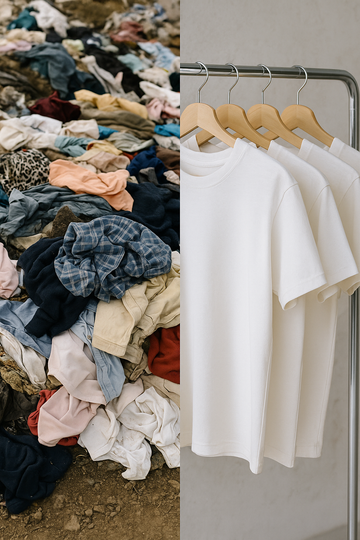A shirt, a dress, a pair of jeans loved for a season, maybe two, and then forgotten. In wardrobes across India, our clothing cycle is shorter than ever. Trends shift, seasons change, and with each change, another pile of “old” clothes begins to grow. We bag them up, toss them out, and move on. But our cast-offs don’t simply disappear.
Imagine this: if the clothes we throw away in just three years were laid out, they could blanket an entire city like Chandigarh. And here’s the grim part most of those garments would sit there for centuries. That is because more than 60% of fabrics used in apparel are synthetic such as polyester, nylon, and acrylic, which are essentially plastics that do not biodegrade (CSE India).
From Landfill to Our Plates
India generates 7,793 kilotonnes of textile waste every year, with 51% coming from post-consumer discarded clothing (Fashion for Good). Much of this waste is synthetic, and it can linger for 200 years or more before breaking down (Sustain Your Style).
In landfills, synthetic fabrics slowly fragment into microplastics, releasing toxic chemicals and dyes into the soil and water. Every wash of synthetic clothing releases up to 700,000 microfibers into wastewater (Environmental Impact of Fashion), and these fibers have been found everywhere from riverbeds to the fish on our plates.

A Brand’s Role in the Story
Fashion brands shape the market through fabric choices, design philosophy, and production ethics. They have the power to slow the waste cycle by producing garments that are built to endure and encouraging consumers to value longevity over fast fashion. In India, a growing number of labels are working with recycled materials, reviving traditional handloom techniques, or running take-back programs to keep textiles out of landfills.
Where DRiP SQUADX Stands
At DRiP SQUADX, we believe great clothes should look and feel just as good in their tenth wear as they did on day one. That is why our core collection is made from premium cotton T-shirts and apparel, chosen not just for their softness but for their ability to retain structure, shape, and sharpness season after season. Cotton naturally breathes, stays comfortable in all seasons, and has a longer comfort lifespan than polyester which means you keep and wear it longer, reducing clothing waste.
Wherever possible, we weave recycled fibers into our fabrics. This reduces the need for virgin materials, keeps useful resources in circulation, and lowers the overall environmental footprint of our garments. We share care instructions to help customers extend the life of their clothes, and we design with timeless style in mind making fashion you will want to keep, not discard.
Our goal is simple: create pieces that respect the planet while elevating your style, so together we reduce waste and slow the cycle of disposable fashion.
The Responsibility We Wear as Consumers
No matter what governments legislate or what brands produce, the impact will remain limited if consumers do not change the way they buy and discard clothes. Every purchase and disposal choice has consequences.
When we see a polyester T-shirt that looks stylish and is priced cheaply, we must ask: Is it really cheap if it pollutes the planet for centuries? Polyester may be strong, but it traps heat, is less breathable, and often gets discarded sooner because it becomes uncomfortable over time. A premium cotton T-shirt, on the other hand, stays comfortable in all seasons and retains its appeal longer meaning we tend to keep and wear it more, extending its life far beyond a quick fashion cycle (Fabric Trace).
We must also find better destinations for the clothes we no longer want. Donating cleaned and wearable clothes to trusted Indian organizations such as Goonj gives them a second life and supports rural communities. Repairing garments, swapping with friends, and reselling items are other ways to keep them in use and out of landfills.
The shift begins when each of us commits to buying consciously, caring for what we own, and parting with clothes responsibly. If we do this collectively, we can turn the tide on India’s growing clothing waste crisis.


